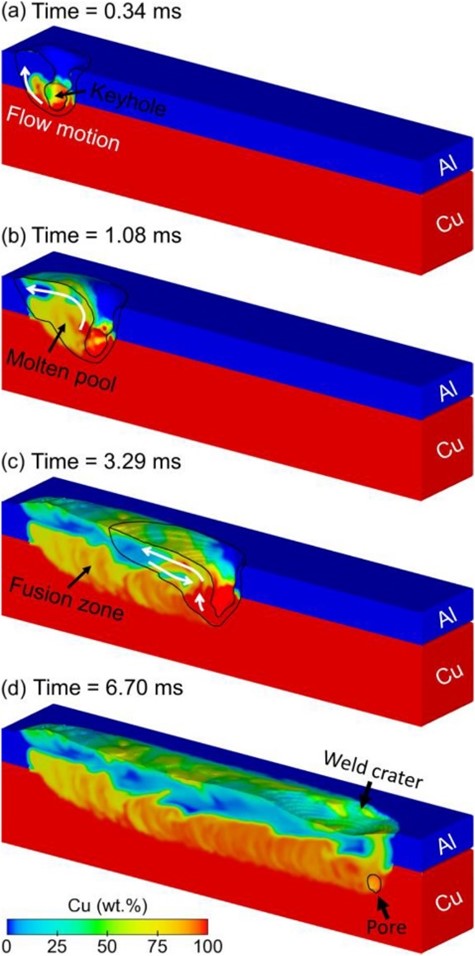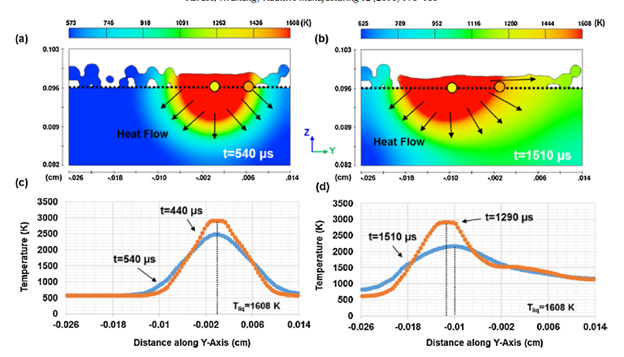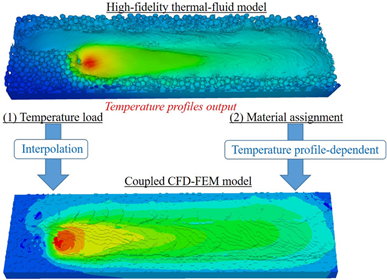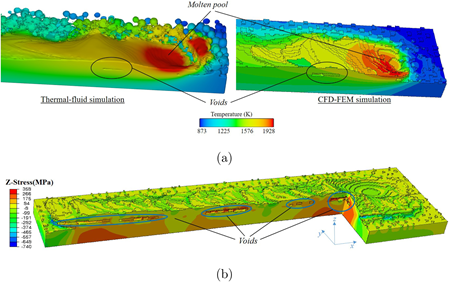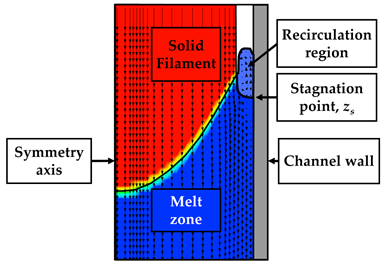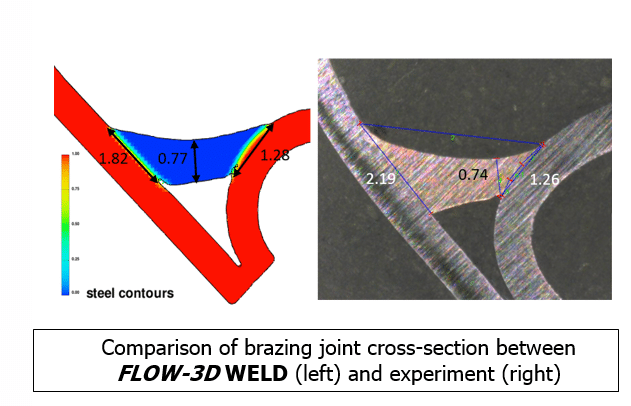FLOW-3D AM and FLOW-3D WELD Case Studies
Explore our FLOW-3D AM and FLOW-3D WELD case studies to learn about real-world applications of CFD to additive manufacturing and laser welding processes. Researchers use FLOW-3D AM and FLOW-3D WELD to gain deeper insights into laser powder bed fusion, multi-material welding, fused deposition modeling, and more.
Multi-Material Welding Case Study
Investigation of metal mixing in laser keyhole welding of dissimilar metals
Researchers from GM and University of Utah used FLOW-3D WELD to understand mixing of dissimilar metals through laser keyhole welding. They looked at the effect of laser power and scan speed on the mixing concentration of copper and aluminum as it relates to recoil pressure and Marangoni convection. They compared simulations with experimental results and found good agreement between material concentrations at cut cross sections within the samples.
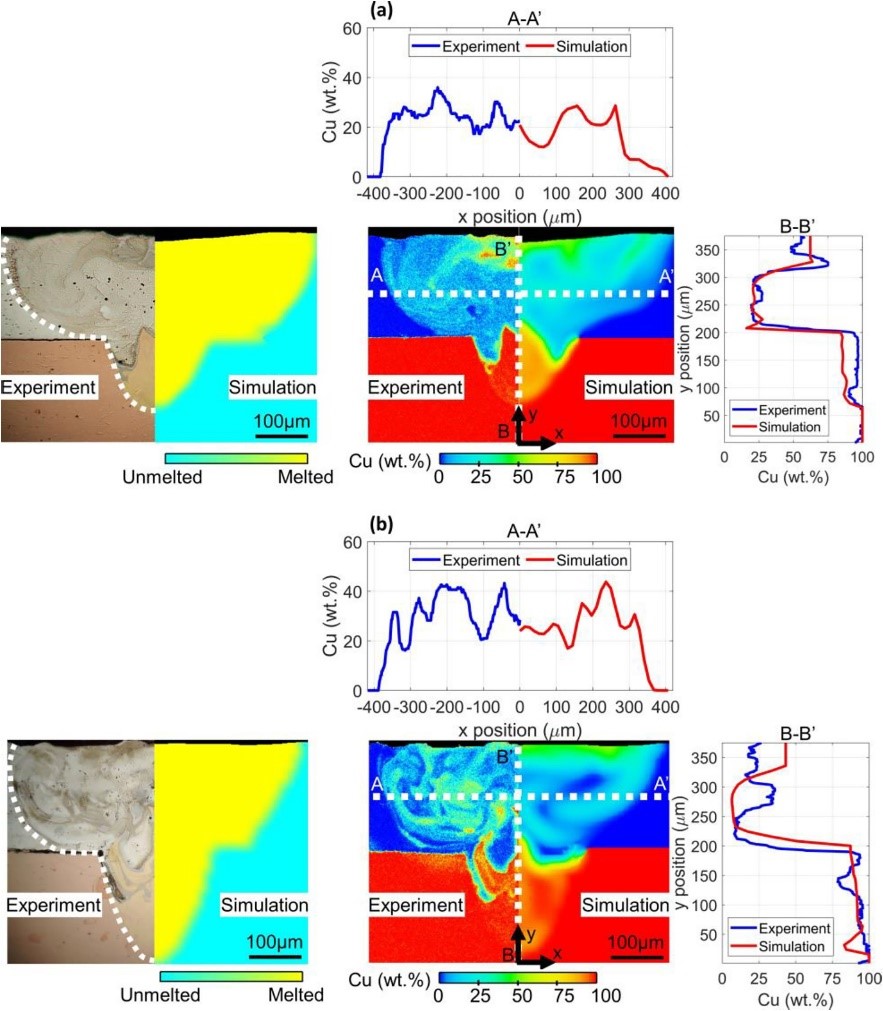
Reference: Wenkang Huang, Hongliang Wang, Teresa Rinker, Wenda Tan, Investigation of metal mixing in laser keyhole welding of dissimilar metals, Materials & Design, Volume 195, (2020). https://doi.org/10.1016/j.matdes.2020.109056
Microstructure Prediction Case Study
FLOW-3D AM data such as cooling rates and temperature gradients can be input into microstructure models to predict the crystal growth and dendrite arm spacing.
Modeling of heat transfer, fluid flow and solidification microstructure of nickel-base superalloy fabricated by laser powder bed fusion
Researchers from Ohio State University extracted thermal gradients and cooling rate data from appropriate locations of the melt pool and the solidus/liquidus interface to predict microstructure evolution in nickel based superalloys.
Reference: Y.S. Lee and W. Zhang, Modeling of heat transfer, fluid flow and solidification microstructure of nickel-base superalloy fabricated by laser powder bed fusion, S2214-8604(16)30087-2, doi.org/10.1016/j.addma.2016.05.003, ADDMA 86.
Thermal Stresses Case Study
High-fidelity modeling of thermal stress for additive manufacturing by linking thermal-fluid and mechanical models
Researchers at National University of Singapore and NUS Research Institute used thermal-fluid modeling with FLOW-3D to model laser powder bed fusion processes and extracted temperature data which was then input into mechanical models to analyze residual stress concentrations. The coupled CFD-FEM model provided insights into the processing parameters which would lead to mechanical failures such as cracking and porosity that correlated with locations of high tensile stress. These simulations were carried out for different laser powers and scan speeds over multiple layers.
Reference: Fan Chen, Wentao Yan, High-fidelity modeling of thermal stress for additive manufacturing by linking thermal-fluid and mechanical models, Materials & Design, Volume 196, (2020). https://doi.org/10.1016/j.matdes.2020.109185
Fused Deposition Modeling Case Study
Numerical modeling of the polymer flow through the hot-end in filament-based material extrusion additive manufacturing
Researchers from the Technical University of Denmark developed a CFD model that sheds light on the FDM process. As the solid filament moves through the liquefier, it contacts the chamber walls that melts the filament. The liquefier then fills up with molten filament. A recirculation region of low temperature and high viscosity is formed near the interface of the solid and liquid filament, which is crucial to preventing the backflow of polymer as seen below.
Such models can illustrate the effects of conduction, convection and radiation on filament melting and flow. The researchers used CFD to study different channel designs that improve heat transfer and maximize the extrusion rate of the filament, ensuring a stable regime. Such models help optimize the pressure drop inside the nozzle, resulting in smaller torque requirements for the stepper motor used to extrude the polymer. This analysis paves the way for faster build rates for fused deposition modeling and a wider adoption of materials that can be additively manufactured.
Reference: Marcin P. Serdeczny, Raphaël Comminal, Md. Tusher Mollah, David B. Pedersen, Jon Spangenberg, Numerical modeling of the polymer flow through the hot-end in filament-based material extrusion additive manufacturing, Additive Manufacturing, 36; 101454, 2020. High-fidelity modeling of thermal stress for additive manufacturing by linking thermal-fluid and mechanical models
Oscillation Welding Case Study
Investigation of Spatter Occurrence in Remote Laser Spiral Welding of Zinc-Coated Steels
Researchers from General Motors and Shanghai Jiao Tong University collaborated to understand the effects of oscillation welding on spatter generation when laser welding zinc-coated steels. The following video shows a comparison of the high-speed imaging of the actual melt pool progression with the corresponding simulation in FLOW-3D WELD. Due to its low boiling point, Zinc vaporizes quickly and entrains within the melt pool, resulting in spatter. Using FLOW-3D WELD, the researchers designed an oscillation-based laser welding schedule that minimized spatter formation and stabilized the melt pool dynamics.
Reference: Shengjie Deng, Hui-Ping Wang, Fenggui Lu, Joshua Solomon, and Blair E. Carlson, Investigation of spatter occurrence in remote laser spiral welding of zinc-coated steels, International Journal of Heat and Mass Transfer, Vol. 140, pp. 269-280, 2019. doi.org/10.1016/j.
Laser Brazing Case Study
Influence of Laser Beam Inclination Angle on Galvanized Steel Laser Braze Quality
Researchers at GM Global R&D and Southern Methodist University used FLOW-3D WELD to understand how process parameters and laser beam inclination influenced the seam quality in laser brazing of galvanized steels. Due to the low boiling point of zinc, the early vaporization caused spatter and other defects. Using simulation, the researchers predicted the positions of the Zinc evaporation front and the wetting front, and by subsequently controlling the beam angle of inclination, the entrainment of the Zinc vapor within the melt pool was mitigated. This resulted in a stable process and a good braze quality.
Reference: Masoud Mohammadpour, Baixuan Yang, Hui-Ping Wang, John Forrest, Michael Poss, Blair Carlson, Radovan Kovacevica, Influence of laser beam inclination angle on galvanized steel laser braze quality, Optics and Laser Technology, 129; 106303, 2020. doi.org/10.1016/j.optlastec.
Laser Keyhole Welding Case Study
How is porosity formed during keyholing? This was the question that researchers from TU Denmark answered using FLOW-3D WELD. As the substrate melts under the application of a laser beam, the recoil pressure due to phase change depresses the melt pool. The co-existence of a downward flow due to recoil pressure and the additional laser energy absorption due to laser reflections causes a runaway effect, transitioning the melt pool into a keyhole. Eventually, due to the varying temperature along the keyhole wall, surface tension forces cause the wall to pinch off and result in voids that can get trapped by the advancing solidification front, resulting in porosity. This can be seen in the video below.
Reference: Mohamad Bayat, Aditi Thanki, Sankhya Mohanty, Ann Witvrouw, Shoufeng Yang, Jesper Thorborg, Niels Skat Tieldje, and Jesper Henri Hattel, Keyhole-induced porosities in Laser-based Powder Bed Fusion (L-PBF) of Ti6Al4V: High-fidelity modelling and experimental validation, Additive Manufacturing, Vol. 30, 2019. doi.org/10.1016/j.addma.2019.100835
